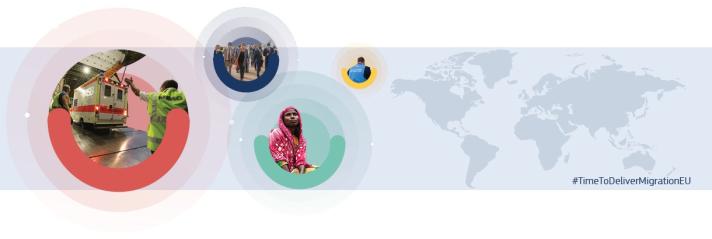An Integrated Political Crisis Response of EU Home Affairs Ministers on the situation at the EU external borders with Belarus – in Lithuania, Latvia and Poland – will take place on Wednesday 18 August. The High Representative and Vice-President Josep Borrell will join us for that important meeting.
Ahead of that meeting, I wanted to recap some of the most important elements. If you don’t have time to read this whole blog, let me summarise it bluntly. Lukashenko is the desperate head of an illegitimate regime who, under pressure of international sanctions, tried to destabilise the European Union and some of its Member States – first Lithuania and now also Latvia and Poland – by sending human beings to our external borders. The EU and all Member States, with great speed and urgency, have come to Lithuania’s aid, and have shown great unity and determination.
And, it is important underlining, the EU, Member States and Lithuania have done so without compromising fundamental values and rights.
This ad hoc crisis response was effective. But we need sustainable and predictable solutions for the long-term. The more we ‘Europeanise’ migration and asylum policy, the more effective our response, and the less vulnerable we will be in the future. Hence my emphasis on how the new Pact on Migration and Asylum is the way forward.
That is the short story, but it is important to give some of the detail and the efforts that have gotten us to this point. They are based on a strength that the EU has developed, a strength perhaps under-recognised. That is the strength to coordinate and deploy rapidly and effectively in a crisis situation.
In eight short weeks, the EU as a whole went from threat to an individual Member State, to call for action, to shared response. And the results are starting to bear fruit.
At the start of June, after an update from Lithuanian Minister Agnė Bilotaitė, and discussions with Home Affairs Ministers in Luxembourg, there was a clear signal to the European border and Coast Guard agency, Frontex, and to the European Asylum support office (EASO) to prioritise our response.
Mid July, at the informal Justice and Home Affairs Council meeting in Ljubljana, an operating plan was already signed between EASO and Lithuanian authorities. Frontex staff and assets were already on their way to the border with Belarus.
On 1-2 August, I visited Vilnius and the border to assess the situation myself and to meet with the President and Prime Minister of Lithuania. My message was clear: the European Commission stands shoulder to shoulder with Lithuania.
This mission was swiftly followed by a team of experts from the Directorate-General for Home Affairs, to make an evaluation of the priority needs.
Based on this evaluation, on 11 August the Commission granted 37 million euro of emergency assistance to Lithuania.
In parallel, the European External Action Services, and High Representative/Vice-President Borrell in particular, has skilfully made our case to the country from which most arrivals were coming, Iraq. Based on coordinated diplomatic efforts with Iraqi authorities, on 6 August, the Iraqi Civil Aviation Authority suspended all new departures from Iraq to Belarus, and Iraqis have started to return home. Since then there has been a significant decrease in the number of irregular arrivals in Lithuania.
But the situation is not over. The sanctions imposed on Belarus are working, making Lukashenko desperate. However, he is attempting to hoodwink other countries into agreeing these illegitimate routes and, to be clear, illegal practices. This will not work.
Why? Because the diplomatic weight and international credibility of the European Union dwarves the efforts of this dictator.
This crisis displayed EU values standing strong under pressure
EU values of solidarity, of democratic principles and of international obligations were on display throughout this crisis. Member States have rapidly come to Lithuania’s aid with experts, law enforcement personnel and equipment and migration processing capacity.
Lithuania has remained calm, it has activated European chains of response, and it has done so with transparency and alacrity.
Poland also demonstrated European values by offering Belarus Olympic athlete Krystsina Tsimanouskaya a humanitarian visa. This is despite the subsequent, and predictable, targeting of the Polish border by the Lukashenko regime.
Future stability is through continuing progress on the Pact for Migration and Asylum
Our challenge on Wednesday is to ensure that this measured, credible and collective response is maintained, updated and further strengthened where needed, also in relation to Latvia and Poland. Neither bow to threats from a dysfunctional regime nor compromise our European values.
I would like to thank the Slovenian Minister Aleš Hojs, President of the Justice and Home Affairs Council, for setting the strong and balanced tone we need. Rationale evaluation and calm and strategic response is the aim. Any attempts to instrumentalise this situation will only play into Lukashenko’s hands.
I look forward to our discussions on Wednesday and I am heartened by the solid foundation we have established together, and upon which we will now further build.
#TimetoDeliverMigrationEU is a weekly blog outlining the benefits of the proposals on migration tabled by the European Commission on 23 September 2020. For more detail on the New Pact on Migration and Asylum see below.
For More information
New Pact on Migration and Asylum | European Commission (europa.eu)
Add link to the Resettlement Recommendation: EUR-Lex - 32020H1364 - EN - EUR-Lex (europa.eu)
Commissioner Johansson’s blog: A transparent and accountable EU-wide asylum and migration system means modern digital infrastructure
Commissioner Johansson’s blog: What a full European Asylum Agency would bring to asylum and migration management
Commissioner Johansson’s blog: More legal pathways to the EU
DG Migration and Home Affairs website: Resettlement and other pathways to protection
Statistics on migration to Europe
Details
- Publication date
- 15 August 2021
- Author
- Directorate-General for Communication



